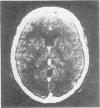Abstract
The handedness of seventy-five persons without evidence of neurological disease, was assessed with a standardised test. An analysis of the CT scans of the same persons was performed to determine (1) presence and lateralisation of frontal and occipital "petalia," (2) width of frontal and occipital lobes of each hemisphere, (3) direction of straight sinus deviation. Results suggest that handedness and cerebral asymmetries are independent variables. There were no significant differences between right-handers and non-right-handers. Also there were no significant differences between strongly left-handed and ambidextrous individuals, nor were there differences between right-handers with or without family history of left-handedness. Irrespective of handedness, left occipital "petalia" was more common than right (p < 0.01), right frontal petalia was more common than left (p < 0.01), and straight sinus deviation was more commonly toward the right. The study does not support the concept that cerebral "symmetry" or "reverse asymmetry" are associated with left-handedness or ambidexterity. The noted asymmetries are more likely to be direct correlates of cerebral language dominance, than of handedness. Furthermore, the possibility that outside forces acting on the bone contributes to the asymmetries cannot be excluded. CT scan may be of value as a direct predictor of cerebral dominance.
Full text
PDF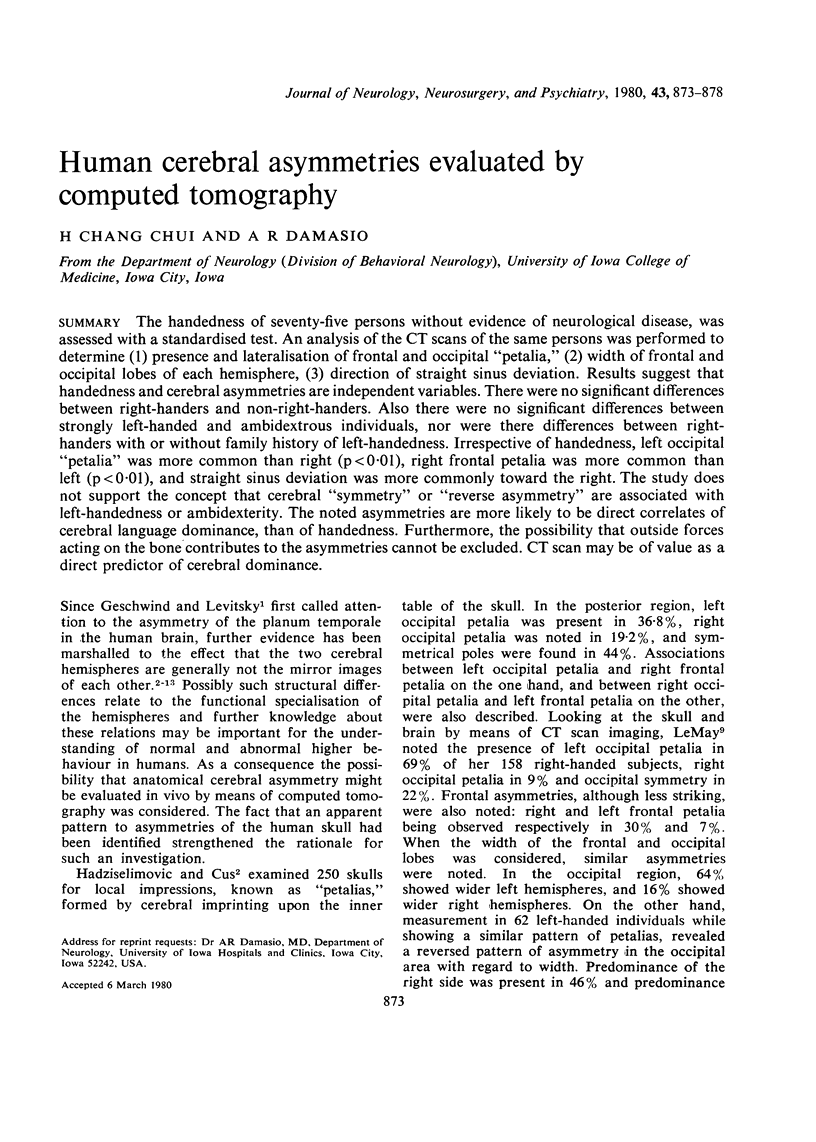
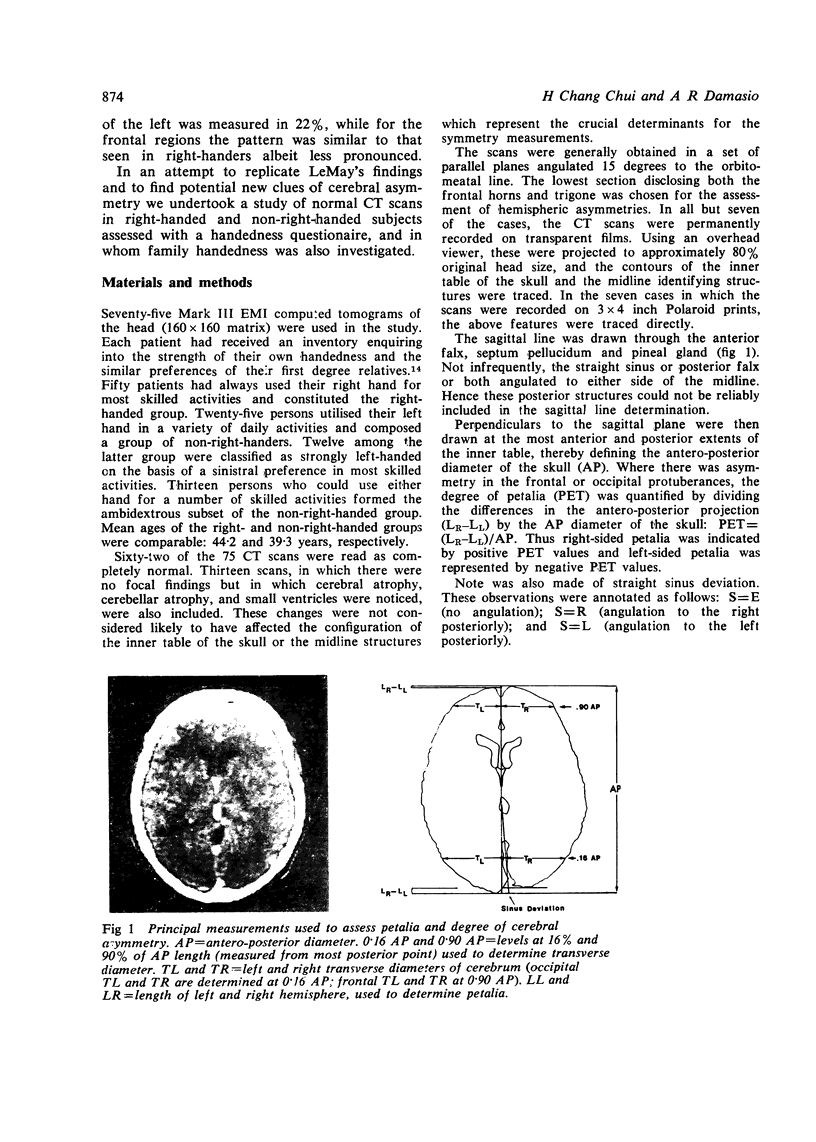
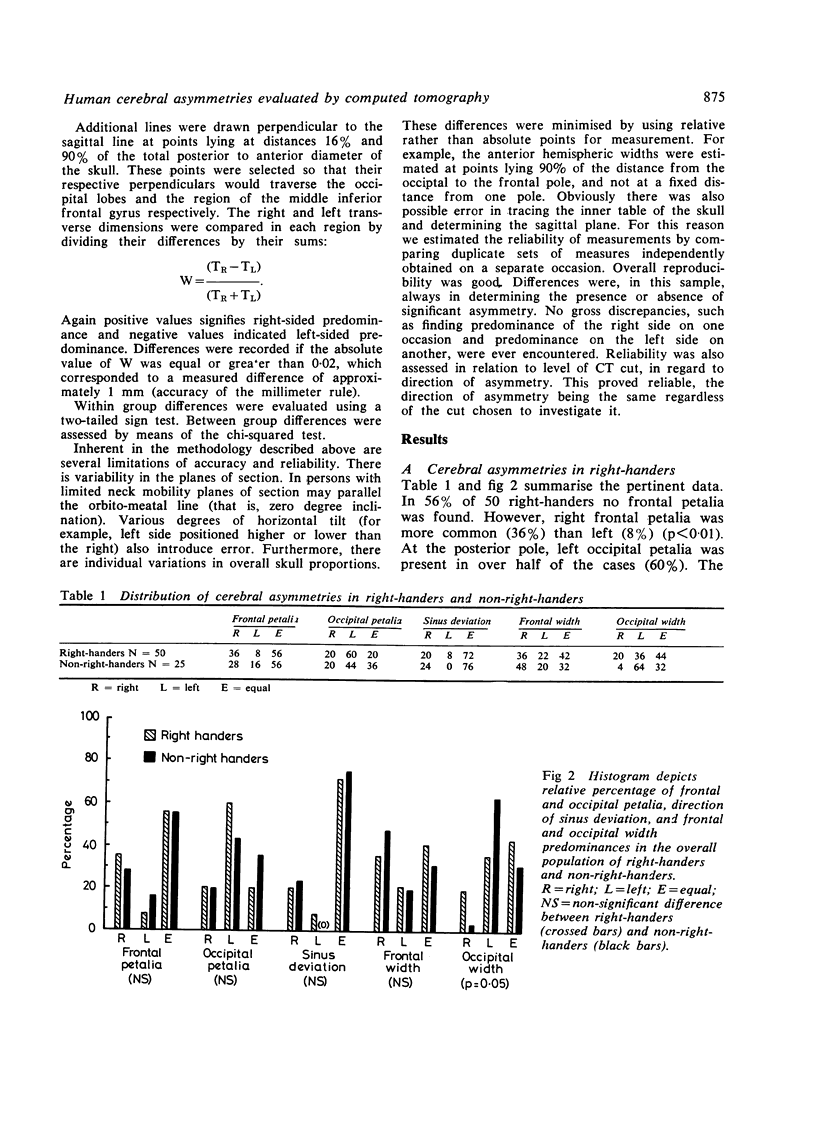
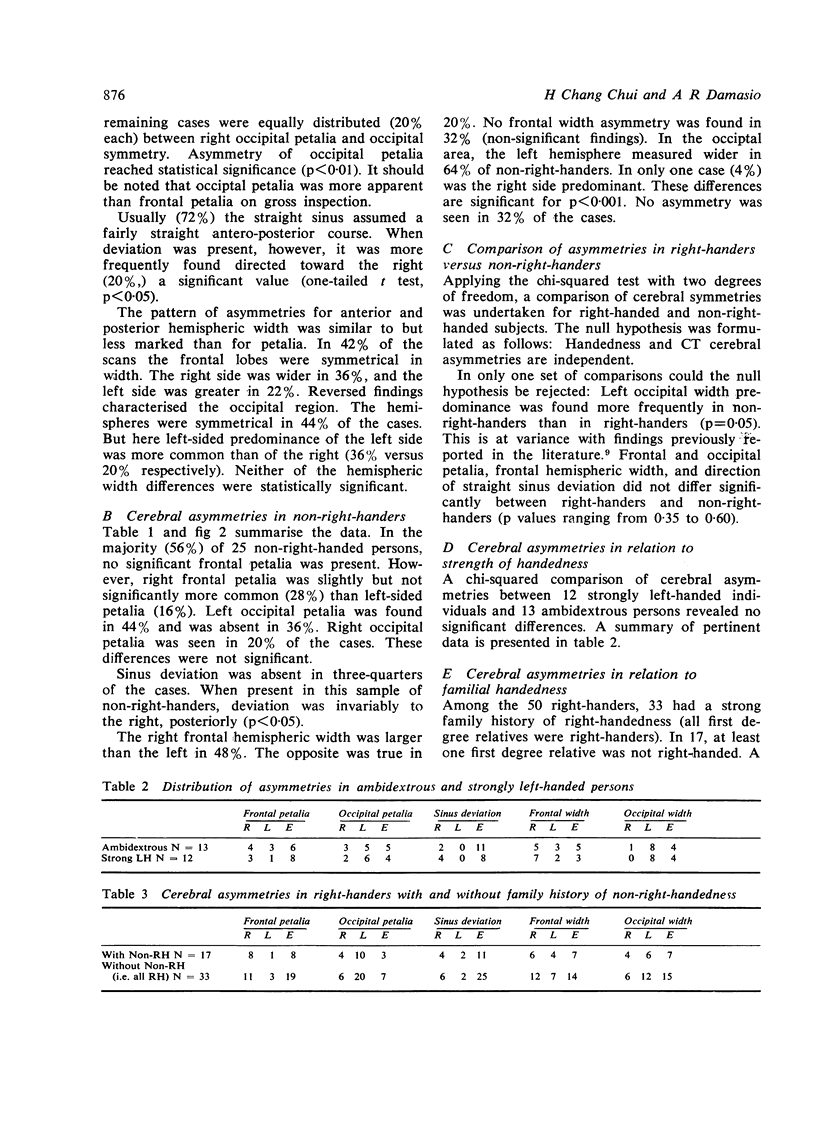
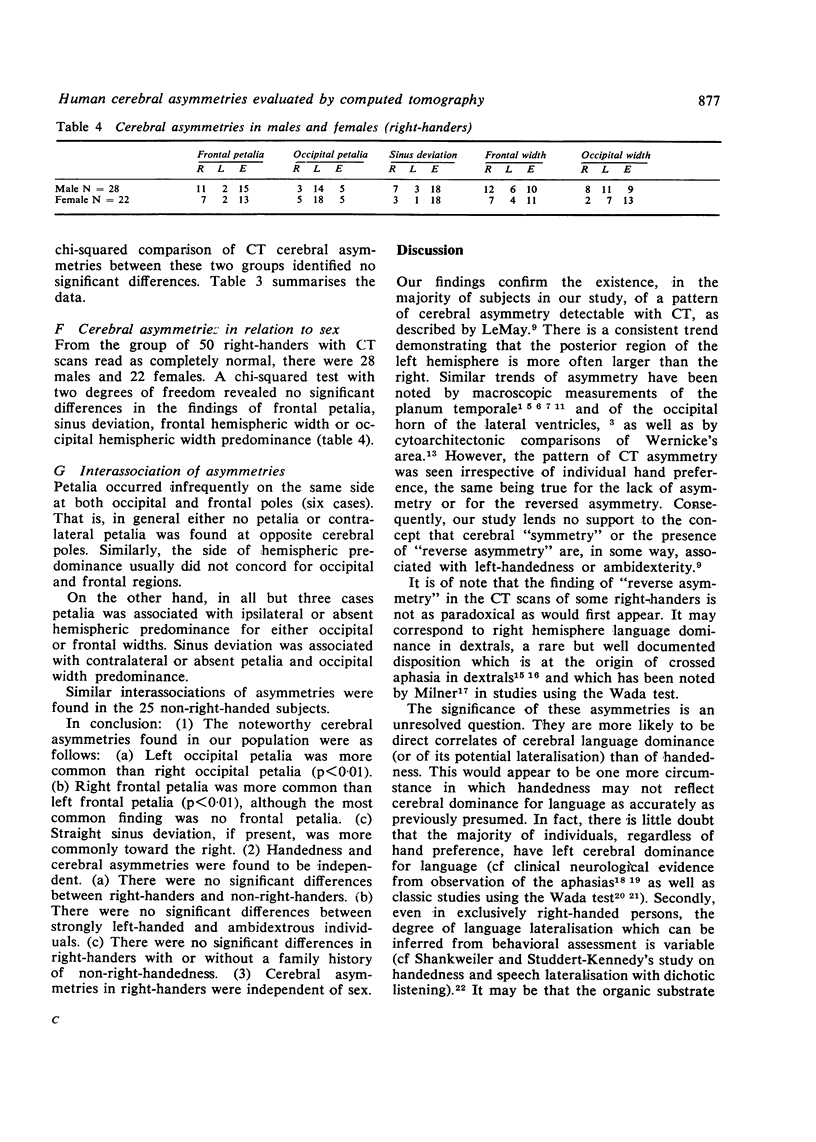
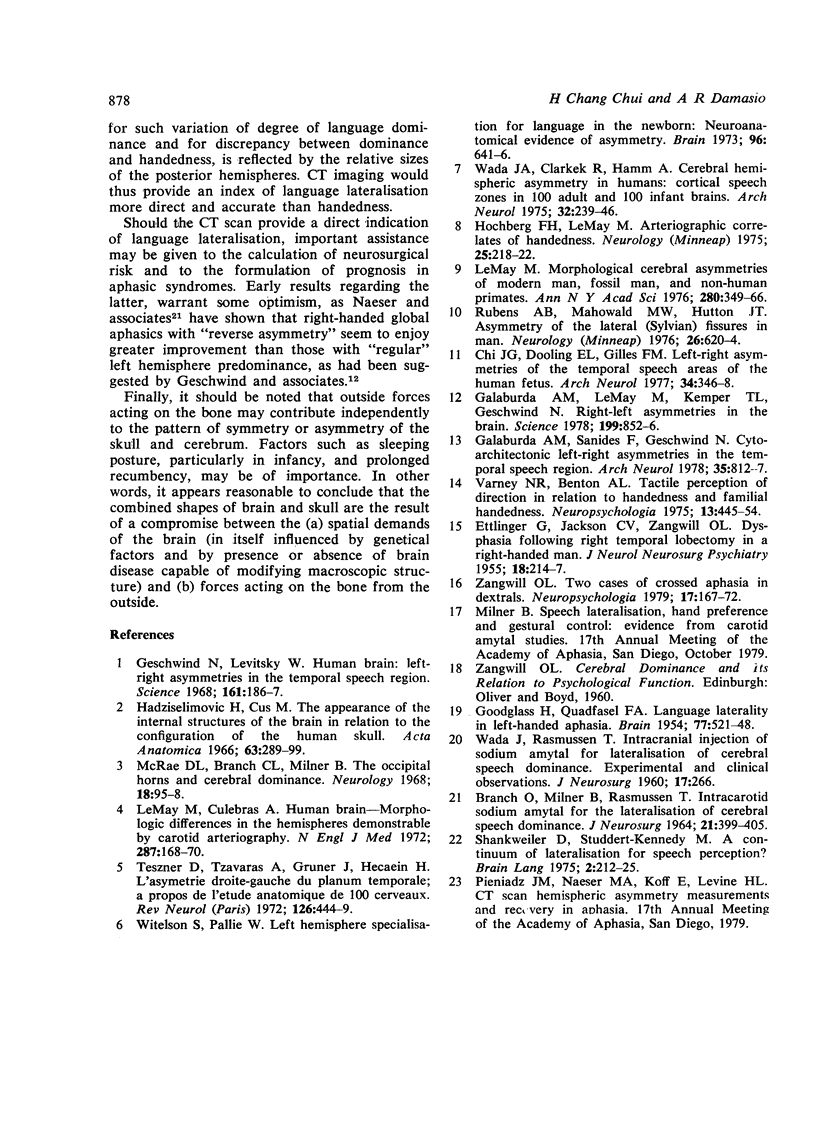
Images in this article
Selected References
These references are in PubMed. This may not be the complete list of references from this article.
- BRANCH C., MILNER B., RASMUSSEN T. INTRACAROTID SODIUM AMYTAL FOR THE LATERALIZATION OF CEREBRAL SPEECH DOMINANCE; OBSERVATIONS IN 123 PATIENTS. J Neurosurg. 1964 May;21:399–405. doi: 10.3171/jns.1964.21.5.0399. [DOI] [PubMed] [Google Scholar]
- Chi J. G., Dooling E. C., Gilles F. H. Left-right asymmetries of the temporal speech areas of the human fetus. Arch Neurol. 1977 Jun;34(6):346–348. doi: 10.1001/archneur.1977.00500180040008. [DOI] [PubMed] [Google Scholar]
- ETTLINGER G., JACKSON C. V., ZANGWILL O. L. Dysphasia following right temporal lobectomy in a right-handed man. J Neurol Neurosurg Psychiatry. 1955 Aug;18(3):214–217. doi: 10.1136/jnnp.18.3.214. [DOI] [PMC free article] [PubMed] [Google Scholar]
- GOODGLASS H., QUADFASEL F. A. Language laterality in left-handed aphasics. Brain. 1954 Dec;77(4):521–548. doi: 10.1093/brain/77.4.521. [DOI] [PubMed] [Google Scholar]
- Galaburda A. M., LeMay M., Kemper T. L., Geschwind N. Right-left asymmetrics in the brain. Science. 1978 Feb 24;199(4331):852–856. doi: 10.1126/science.341314. [DOI] [PubMed] [Google Scholar]
- Galaburda A. M., Sanides F., Geschwind N. Human brain. Cytoarchitectonic left-right asymmetries in the temporal speech region. Arch Neurol. 1978 Dec;35(12):812–817. doi: 10.1001/archneur.1978.00500360036007. [DOI] [PubMed] [Google Scholar]
- Geschwind N., Levitsky W. Human brain: left-right asymmetries in temporal speech region. Science. 1968 Jul 12;161(3837):186–187. doi: 10.1126/science.161.3837.186. [DOI] [PubMed] [Google Scholar]
- Hadziselimović H., Cus M. The appearance of internal structures of the brain in relation to configuration of the human skull. Acta Anat (Basel) 1966;63(3):289–299. [PubMed] [Google Scholar]
- Hochberg F. H., Le May M. Arteriographic correlates of handedness. Neurology. 1975 Mar;25(3):218–222. doi: 10.1212/wnl.25.3.118. [DOI] [PubMed] [Google Scholar]
- LeMay M., Culebras A. Human brain--morphologic differences in the hemispheres demonstrable by carotid arteriography. N Engl J Med. 1972 Jul 27;287(4):168–170. doi: 10.1056/NEJM197207272870404. [DOI] [PubMed] [Google Scholar]
- LeMay M. Morphological cerebral asymmetries of modern man, fossil man, and nonhuman primate. Ann N Y Acad Sci. 1976;280:349–366. doi: 10.1111/j.1749-6632.1976.tb25499.x. [DOI] [PubMed] [Google Scholar]
- McRae D. L., Branch C. L., Milner B. The occipital horns and cerebral dominance. Neurology. 1968 Jan;18(1 Pt 1):95–98. doi: 10.1212/wnl.18.1_part_1.95. [DOI] [PubMed] [Google Scholar]
- Rubens A. B., Mahowald M. W., Hutton J. T. Asymmetry of the lateral (sylvian) fissures in man. Neurology. 1976 Jul;26(7):620–624. doi: 10.1212/wnl.26.7.620. [DOI] [PubMed] [Google Scholar]
- Shankweiler D., Studdert-Kennedy M. A continuum of lateralization for speech perception? Brain Lang. 1975 Apr;2(2):212–225. doi: 10.1016/s0093-934x(75)80065-4. [DOI] [PubMed] [Google Scholar]
- Teszner D., Tzavaras A., Gruner J., Hécaen H. L'asymétrie droite-gauche du planum temporale; á propos de l'étude anatomique de 100 cerveaux. Rev Neurol (Paris) 1972 Jun;126(6):444–449. [PubMed] [Google Scholar]
- Wada J. A., Clarke R., Hamm A. Cerebral hemispheric asymmetry in humans. Cortical speech zones in 100 adults and 100 infant brains. Arch Neurol. 1975 Apr;32(4):239–246. doi: 10.1001/archneur.1975.00490460055007. [DOI] [PubMed] [Google Scholar]
- Witelson S. F., Pallie W. Left hemisphere specialization for language in the newborn. Neuroanatomical evidence of asymmetry. Brain. 1973 Sep;96(3):641–646. doi: 10.1093/brain/96.3.641. [DOI] [PubMed] [Google Scholar]
- Zangwill O. L. Two cases of crossed aphasia in dextrals. Neuropsychologia. 1979;17(2):167–172. doi: 10.1016/0028-3932(79)90007-1. [DOI] [PubMed] [Google Scholar]



